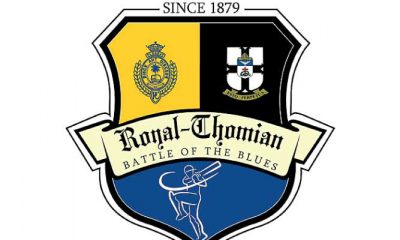Sports
The Royal-Thomian will be open to the public after a dearth of two years
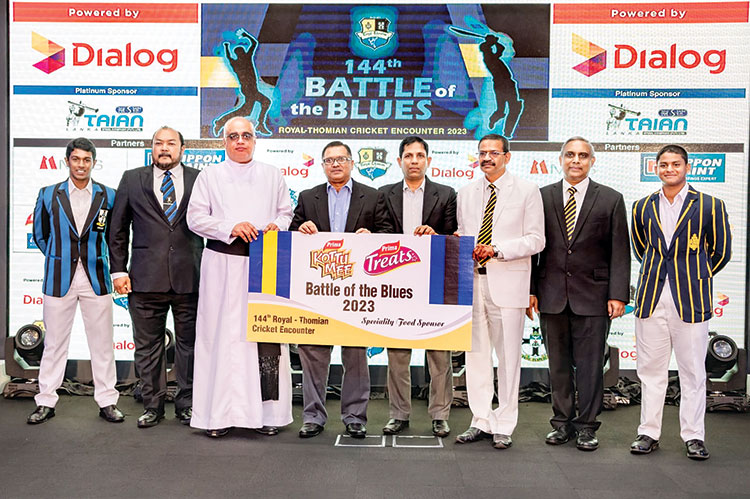
144th Battle of the Blues Powered by Dialog
With the de-restriction of COVID-19 safety protocols on public events, Sri Lanka’s longest-running cricket series played between Royal College, Colombo, and S. Thomas’ College, Mt. Lavinia will be battled out in its full glory for the 144th uninterrupted time for the prestigious Rt. Hon. D S Senanayake Memorial Shied from March 16th to 18th 2023 at the Sinhalese Sports Club, Colombo 07.
The 144th edition of the Royal-Thomian will be the 18th year that the match is sponsored by Sri Lanka’s premier connectivity provider, Dialog Axiata PLC.
Due to the unprecedented times in the last two years owing to the COVID-19 pandemic, the matches were played behind closed doors for the safety of players. However, with the easing of COVID-19 restrictions the Joint Match Organising Committee of the Royal – Thomian, under the guidance of the heads of the two respective schools has decided to play the 144th edition of Sri Lanka’s blue ribbon big match, the Battle of the Blues encounter in full attendance to ensure the Royal-Thomian fraternity is able to enjoy the event as done in the past.
The 144th ‘Battle of the Blues’ cricket encounter will go LIVE on Dialog Television channel number 22, and will also be available via LIVE stream on ThePapare.com and the Dialog ‘Viu’ app. The limited-over ‘Mustang’s Trophy’ match will be played on Friday 24th at the same venue.
As a kind gesture of uplifting schools’ cricket, Dialog Axiata PLC in 2015 made a pledge to contribute 1,000 rupees for every run scored and 10,000 rupees for every wicket that fell. Last year’s encounter contributed Rs. 834,000 to the ‘Play for a Cause’ pledge. The proceedings were distributed in consultation with the Principal of Royal College and the Warden of S. Thomas’ College to support and empower deserving schools in the country.
In this year’s encounter, the boys from Mt. Lavinia will be led by stumper Romesh Mendis, while the lads from Reid Avenue will play under the captaincy of all-rounder Dasis Manchanayake.
‘The Royal – Thomian’ has a rich and colourful history spanning across 143 years and is also the second longest uninterrupted cricket series played in the world, second only to the annual encounter played between St. Peters College – Adelaide and Prince Alfred College – Adelaide, Australia, that began just a year earlier. The Australia vs England Ashes Series commenced two years later in 1882.
In 1880, the first match in which only the boys took part was played at Galle Face, the present location of the Taj Samudra Hotel. This was the start of the century-old series. Both teams are said to have rowed in boats across the Beira Lake to play the match.
The playing fields of the ‘Roy – Tho’ has the distinction of producing cricketers who later became eminent heads of state, with S. Thomas’ producing the father of the nation, the late Rt. Hon. D. S. Senanayake MP (1901 – 1902), whom the Shield is named after, and his son, the late Hon. Dudley Senanayake MP (1927-1929) as Prime Minister of Ceylon, while Royal produced the late Rt. Hon. (General) Sir John Kotelawala MP (1914-1915) as Prime Minister and the first Executive President of Sri Lanka, the late J. R. Jayawardene (1925).
The tally between the two schools at present stands at 35-all, with the highly-debated match in 1885, where Royal College was all out for nine runs and refusing to play on the second day which was considered a win by S. Thomas’ and considered a draw by Royal as shown in the respective souvenir books of the two schools. The shield at present sits as the crown jewel, amongst the silverware in the Warden’s trophy cabinet at S. Thomas’ College – Mt. Lavinia, after putting up a superb performance in 2019 under the captaincy of Sithara Hapuhinna, which will be challenged by a determined Royal XI this year, who have put on some heavy scores against their opponents in the 2023 season. The boys from Reid Avenue last won the coveted shield under the stewardship of Geeshanth Paditharatne in 2016.
Played in the highest tradition of excellence, the two schools have a formed a bond of mutual respect, camaraderie, sportsmanship, and friendly adversaries on and off the field, which has stood for almost one-and-a-half centuries. As remarked by a yesteryear Principal of Royal College: “There is no Royal without S. Thomas’ and no S. Thomas’ without Royal.”
Dialog Axiata is the proud sponsor of the Sri Lanka National Cricket, Volleyball, Netball and Esports teams. The Company also has a close association with the President’s Gold Cup Volleyball, National Junior and Senior Netball tourneys, Schools Rugby, Premier Football and Paralympic sports by powering the Army Para Games, National Para Games and the Sri Lankan contingent to the World Paralympic Games.
Sports
Lankan legends, Modi and the Jaffna dream
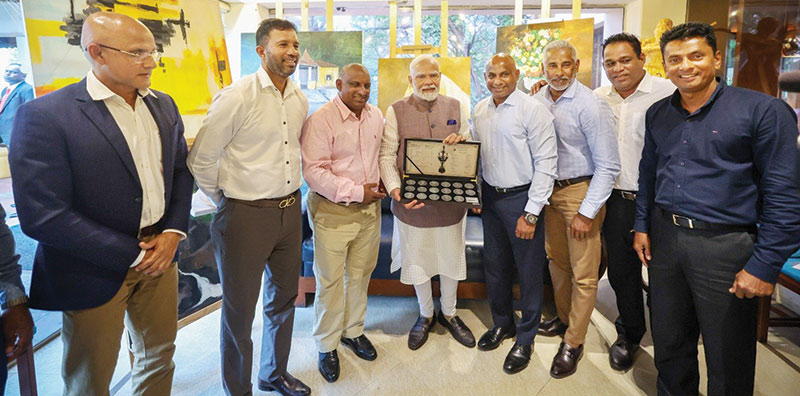
Tamil Members of Parliament with roots across the Palk Strait are often quick to look towards India at the drop of a hat. But last week, all they managed was a photo op with Indian Prime Minister Narendra Modi – smiles, handshakes and little else. In contrast, Sri Lanka’s 1996 World Cup-winning cricket team was granted a 45-minute chinwag over tea with the Indian leader. The Indian High Commission in Colombo had arranged the meeting. Not even former President Ranil Wickremesinghe, with all his so-called diplomatic finesse, has managed to get a similar audience.
Pictures of Modi rubbing shoulders with Sanath Jayasuriya and Aravinda de Silva went viral in India on social media and it was the talking point across news channels and print media as well. And why not? Not since the marauding days of Sir Vivian Richards have Indian bowlers been sent on a leather hunt quite like they were by these two Sri Lankan giants. It was déjà vu for Indian fans – memories of the Wills World Cup semi-final at Eden Gardens, still fresh like an old wound that refuses to heal.
During the meeting, Jayasuriya pitched an idea to the Indian PM – seeking help to build a cricket stadium in Jaffna. It wasn’t a doosra out of nowhere. There’s a deep and genuine passion for cricket in the north. Some of the school big matches in the region have stood the test of time, with legacies stretching back over a century. Yet, due to decades of conflict, the region has remained a barren patch in terms of producing top-tier cricketing talent.
Since the guns fell silent, though, there’s been a fresh crop of hopefuls from the north. Leading the charge is leg-spinner Vijayakanth Viyaskanth – a name that’s now turning heads. Though his First-Class stats are more than decent, Viyaskanth has chosen the glitz and glamour of franchise cricket, where the pay cheques are fatter and the schedule less grueling.
Behind the scenes, Sri Lanka Cricket’s (SLC) District and Provincial coaches have done a stellar job, scouting and grooming pace bowlers and other youngsters from these long-neglected areas. Some of these boys have gone on to wear the Under-19 jersey with pride – a sign that the talent pool is slowly, but surely, filling up.
However, SLC’s grand vision of building new stadiums to attract larger crowds has hit a few bumps. The old guard – some former greats – have been quick to swing the bat in criticism. They’ve taken their eye off the ball, failing to see the bigger picture. Take next year’s T20 World Cup, for instance. Co-hosted by Sri Lanka and India, it promises to be a blockbuster. The high-voltage India – Pakistan clash is set to take place in Colombo, with the R. Premadasa Stadium’s 35,000 seats expected to vanish like isso vade at the Galle Face green. A bigger venue – like the proposed facility in Homagama – would have been just the ticket to meet such mammoth demand.
But Sanath’s plea is in a different league altogether. He’s not asking for a behemoth like Eden Gardens or the Narendra Modi Stadium in Ahmedabad. His is a humble request – a ground with decent infrastructure and floodlights that can host day-night matches. A facility like that would be a game-changer for the north, a true shot in the arm. Nothing ignites a young cricketer’s imagination more than watching their heroes up close, not through a television screen but under the stars, in their own backyard.
At present, the closest international venue to Jaffna is in Dambulla—hardly accessible, especially for aspiring fans and players from the peninsula. A ground in Jaffna would not only bridge that distance but also build a bridge of hope and opportunity.
Back in 2002, when Janashakthi opened a branch in Jaffna, the great Muttiah Muralitharan made the long road trip to play a friendly match on a matting wicket. The welcome he received was nothing short of electric. The crowd adored him, showering him with affection that could rival the warmth of any southern stand.
Since then, we’ve hardly scratched the surface when it comes to understanding the region’s cricketing appetite. If the Indian government lends an ear to Sanath’s appeal, we might just discover a goldmine of talent waiting to be unearthed in the north. Who knows? The next Murali or Malinga might be bowling on a dusty street in Jaffna this very moment – waiting for a stage, a spotlight, and a bit of help from across the Palk Strait.
by Rex Clementine
Sports
Sri Sumangala’s cricketing miracle
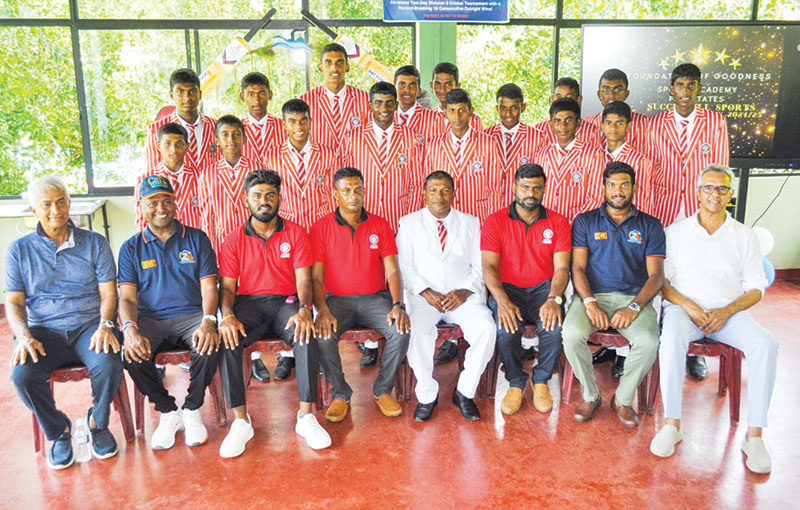
Sri Sumangala Vidyalaya, Hikkaduwa has scripted a fairytale rise in school cricket, marking a monumental milestone just 18 years after forming its first team. Once deprived of even a proper ground, the school now proudly boasts an unbeaten Under-19 team that has clinched both the Division III two-day and one-day championships — a rare double that has earned them promotion to Division 2.
The turnaround began in 2007 when the Marylebone Cricket Club (MCC) helped establish the Sri Sumangala MCC Lord’s Cricket Grounds following the devastating tsunami. This facility, offered free of charge, became a beacon for young cricketers who had talent but lacked opportunity. What followed is nothing short of a sporting miracle: 16 consecutive outright wins by the U19 team and national recognition in school cricket circuits.
This isn’t just a story of trophies and titles — it’s about breaking generational barriers. These young cricketers, once trapped in a cycle of poverty and obscurity, now inspire their community and set benchmarks for others in rural Sri Lanka.
The MCC’s early investment has borne fruit, turning dreams into tangible success. Today, the legacy of Lord’s lives not only in London but also in the hearts of the aspiring cricketers of Hikkaduwa — proof that when given a chance, talent can indeed take flight.
Foundation of Goodness has been a beacon of hope for sporting talents in the region and representation for Sri Lanka Women’s Under-19 team has been dominated by them. The same could happen with the men’s team in the near future.
Sports
St. Sebastian’s back on the basketball track
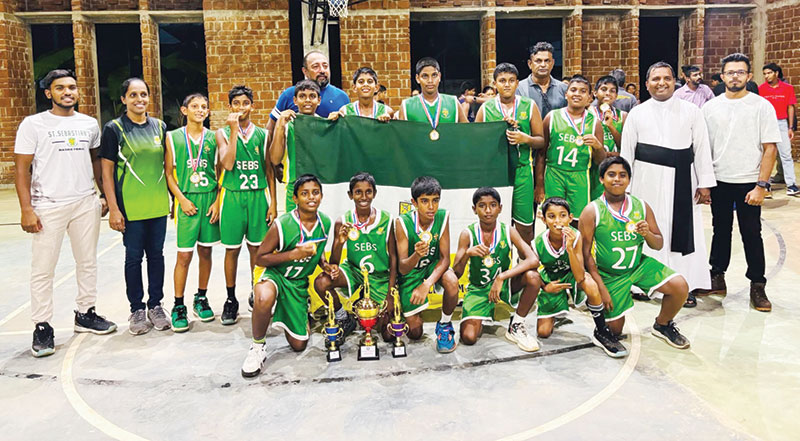
In the bygone years it was the Colombo schools that dominated basketball in Sri Lanka. Bens under Ram Sunderalingam, Peterites coached by Naufer Mahroof and the Josephians shaped by Mahadevan were the trojans who won tournaments. Led by this trio and flanked by other basketball playing schools in the capital, the game had its foundation laid down in concrete – Colombo style.
Moratuwa and Batticaloa were the painful thorns amidst the Colombo teams when it came to championships. And Trinco was the dark horse, almost unbeatable in their heyday, playing under the wizard, late Father Eugene Herbert. This is what basketball was, beginning from the sixties.
Today the faded memories remain. On a lucky day one might meet Doc Thurai, as he was popularly known, walking his wards with the stethoscope round his neck. He was the best we saw in that era. If one visits Batticaloa there is a prominent statue outside the town. It is of a tall Jesuit Priest. Here, he cradles a Wilson basketball ready to take a ‘time-out’ and yell at the referee. That is Father Herbert, the man who filled the Eastern Province with stellar players who left their luminous mark in the basketball courts of Sri Lanka.
More recently in April, on the 6th Sunday, I watched the under 13 ‘B’ division basketball finals between St. Sebastian’s and St. Thomas’ Prep. It was played at a flood-lit indoor court in Moratuwa. No, it certainly wasn’t in the league of Madison Square Garden, but it was more than adequate for a schools’ final. I sat on a wooden bench and watched the match thanking the court creator Sugath Thevarapperuma. I must mention this former national player who is doing yeomen service to promote basketball by establishing indoor courts in different locations.
Back to the match. It was good and exciting and the Sebastians won 37-36 by a solitary point. This was great for Moratuwa and the school and the young players. This victory would awaken the school and the basketballers from the doldrums they had been mired for a considerable time to say ;we are coming back’.
This 1-point victory I witnessed appeared to me as a catalyst for greater performances and perhaps an eye-opener for the Moratuwa lads. They are indeed capable of leaping bigger steps to reach higher pedestals in schools’ basketball championships. Yes, that is an achievable possibility, and the need is to change gears and go for the over-drive.
It is time for St Sebastian’s to forget the apathetic era and the reasons for such, and forge ahead with renewed motivation to re-claim former glories with their current potential.
The Thomians fought to the end. They certainly were equal in spirit and determination to become the champions. The difference was simply 1 solitary point. The pattern of play was the same by both teams and the award for the best player went to Akash Wijesinghe and Amantha Hettiarachchi was adjudged the best guard.
I noticed that some new rules have been introduced to control the game. The teams are only allowed to play ‘man-to-man’ and they could do so only from the center line. Additionally, the coach cannot use a double guard on the opposing best player. The teams are not allowed to use a zonal defense or play a floating man to man. If these rules came from FIBA then there is no argument. But if it is a local ramification of rules of how the game should be played, I have to humbly say that this will be a significant deterrent to coaches and players and a recurring headache to the referees. Over to you Sir, the Head of the Schools’ Basketball Association.
For me personally, it was an ‘Alma Mater delight’ to notice that the two coaches of the playing teams were both from St Sebastians and the assistant coach too was from my old school. Chaminda de Alwis and Susil Dias coached St. Sebastian’s and Isuru Perera the Thomians.
Chaminda captained the national team and Isuru had Ceylon Basketball colours and Susil represented All Island Schools.
Yes, St. Sebastian’s had a lot of glory days in basketball. Many of their players represented and captained the national team. Then one might ask, “how come they hit rock bottom playing a game they more or less dominated?”
The answer is simple, I will leave it for another day to elaborate.
On second thoughts, some things are best left unsaid.
by Capt. Elmo Jayawardena
elmojay1@gmail.com
-

 Business7 days ago
Business7 days agoColombo Coffee wins coveted management awards
-

 News2 days ago
News2 days agoSuspect injured in police shooting hospitalised
-

 Features3 days ago
Features3 days agoRobbers and Wreckers
-

 Features5 days ago
Features5 days agoSri Lanka’s Foreign Policy amid Geopolitical Transformations: 1990-2024 – Part III
-

 Midweek Review5 days ago
Midweek Review5 days agoInequality is killing the Middle Class
-

 Features7 days ago
Features7 days agoSri Lanka’s Foreign Policy amid Geopolitical Transformations: 1990-2024 – Part I
-

 Business2 days ago
Business2 days agoSanjiv Hulugalle appointed CEO and General Manager of Cinnamon Life at City of Dreams Sri Lanka
-

 Features6 days ago
Features6 days agoA brighter future …



